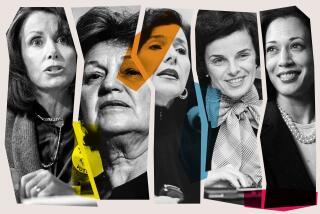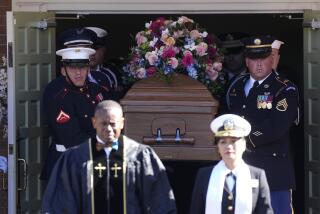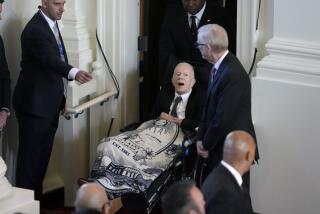First Solo Flight : Barbara Bush’s Personal Style Proves Popular in Her Diplomatic Debut Abroad
- Share via
WASHINGTON — It happened one night in February over white wine and fish in Miami, when two young and decidedly fashionable couples were dining and reminiscing. Their conversation was relaxed and comfortable, full of discussions about family and an election going on that night in Nicaragua.
The talk at one point turned to an upcoming big event in one of the couples’ lives.
Who, asked the President-elect of Costa Rica, would represent the United States at his inauguration?
“Your mom would be a good choice,” Rafael Angel Calderon Jr. told his host, presidential son Jeb Bush.
He replied: “She is probably as close to the President of the United States as any living human being.”
And thus was an idea hatched among Rafael and Gloria Calderon and Jeb and Columba Bush--friends who had met at the 1984 Republican Convention--lead America’s First Lady southbound this week for her first overseas diplomatic mission on her own.
But just because Barbara Bush was overseas representing her husband and her country didn’t mean that she would alter her much-publicized and popular personal style.
No, the First Lady became a hit in Central America by displaying what can only be called Bush diplomacy, down-home style, with a decidedly personal touch.
The scene Tuesday in San Jose, the capital of Costa Rica, could only have been choreographed by the most ardent First Lady fan.
Mrs. Bush led the U.S. delegation to President-elect Calderon’s inauguration. She made her way waving and smiling along a red carpet in National Stadium, which had been turned blue for the day because that’s the color of Calderon’s triumphant Social Christian Unity Party.
Tens of thousands of Costa Ricans were present. They waved, clapped and howled the First Lady’s name. “Bar-ba-ra! Bar-ba-ra!” they chanted. “Say hi to your husband, Mrs. First Lady!” one onlooker shouted.
For Mrs. Bush, this was just the beginning of a seven-hour event. It was “one of the longest ceremonies I’ve ever been to,” she later would say.
But for the First Lady, Calderon’s inauguration--an event that he had so hoped would be filled with important world figures that he even had sent a long telegram inviting South Africa’s Nelson Mandela, who had turned him down--also turned into an occasion to greet old friends and to make new best friends.
On the sprawling platform of inaugural dignitaries were all of Central America’s heads of state. Many of them, and the other important people, wanted to greet the woman who many Americans have said they wished were their own mother.
And they did exchange words. As Mrs. Bush tells it, in her slightly upper crusty Katharine Hepburn drawl, she loooved them all.
The First Lady, for example, found the time for a long chat with Nicargua’s President Violeta Chamorro.
They didn’t talk about the Contras and American aid. They did talk about Nicaragua’s orphans and broken bones. (Chamorro broke a leg, an injury that some wrongly had predicted might hamper her ability to campaign for the office she won in a stunning upset.)
While Calderon, the newly elected president whose people affectionately call him Junior, was offering 25,000 Costa Ricans his vision for their country, his own children kept finding their way back to Mrs. Bush to say “hi.”
How personal were the ties between the Bushes and the Calderons?
“I fell in love with the Calderon family,” Mrs. Bush told reporters.
She explained that she had invited the Calderons’ four children “to come live with me but they turned me down, I’m sad to say.”
It took considerable protocol and letter writing to get the First Lady to go to Costa Rica without her husband. But after all, that initial invitation had come via the channel that George and Barbara relish--through family and friends.
Indeed, during Mrs. Bush’s 21 hours in Costa Rica, it seemed her trip was not as much about reinforcing the President’s hopes and desires for peace and democracy in Central America, as it was about Rafael meeting the mom of his friends Jeb and Columba.
Mrs. Bush, even before she got off the plane in Costa Rica, had tried to emphasize the highly personal nature of her visit, a trip she said that sought to highlight the links between two families and two countries that had much in common--besides a history of stable democracy and an obsession with cable television.
“I hope (my presence) brings a message of friendship,” she said in her chatty manner.
It was at a private breakfast on inauguration morning that the Calderons (including grandma and the four kids) and the Bushes (including the First Lady and Jeb, though not Columba, who stayed home with ailing Jebby, 6) became pals.
Just after Mrs. Bush walked in the Calderons’ sprawling white stucco home, Marco Calderon, 8, ran up to the First Lady and embraced her. “I saw you on the Disney channel,” he said.
Mrs. Bush was thrilled. “My mom was real impressed with the well-adjusted nature of all the kids,” Jeb Bush said.
Over a breakfast of huevos rancheros and fruit, the families traded old war stories of the campaign trail, Jeb Bush recalled, adding, “We all laughed a lot about the things that go on.”
But at one point Mrs. Bush--who has spent a lifetime in politics at her husband’s side, a reality for which she only recently has been criticized by some college-age women--grew serious.
She told Calderon, 41--who in just a few hours would be fulfilling his lifelong dream of following in his once exiled father’s footsteps--that George Bush had thought a lot about his own father on his election day.
It was a moving moment for Calderon, whose father had started as a politician beloved by his people, had served as president from 1940 to 1944, but then ended his career in exile after his electoral defeat sparked a bloody civil war.
The Calderons ought to be just the type of people with whom folks like Mrs. Bush should feel comfortable.
Like her family, the Calderons have public service and politics coursing through their blue-blood veins.
Like the Bushes, the Calderons received elite educations, including the best America had to offer.
The Costa Rican first family also inherited great wealth.
When Calderon’s mother, Maria del Rosario Fournier del Calderon, met the First Lady--who counts among her distant relatives U.S. President Franklin Pierce--she told her in halting English, “I was the wife of a president, the daughter-in-law of a vice president and now am the mother of a president.”
Her son Rafael no sooner graduated from law school than he started running for office. Twice he lost presidential campaigns; in the meantime, he served in his nation’s parliament and as foreign minister. He also held other government posts.
When asked if she could identify with a two-time loser who wins on this third try, Mrs. Bush replied: “I hadn’t thought about it, but I guess there’s a lesson in that. How old is he? 41?
“I don’t have too much empathy for him,” joked the woman whose husband, himself the son of a U.S. senator, has had a long political career with stints as a congressman, ambassador, CIA chief and vice president before making it to the White House.
Politics, of course, is what best links the Bushes and the Calderons. They are all what may be regarded as being moderate conservatives. The Republicans in the United States and the Social Christian Unity Party in Costa Rica have strong ideological ties. During his winning electoral battle against an opponent supported by Oscar Arias, the Nobel Peace Prize winner and his predecessor, Calderon received considerable financial and campaign support from the GOP.
A senior White House official observed that the Costa Rican people had no trouble picking up on the personal and political connections between the Bushes and the Calderons: “There were a lot of very personal kinds of comments from the stands, which I think is just a reflection of how effective the Bushes’ liking of the people gets transferred,” he said.
Mrs. Bush expressed astonishment that she encountered no protests, not even one negative sign during her visit.
“I got nothing but good hand gestures,” she deadpanned.
Anna Perez, her press secretary, said the First Lady had minor trepidations before arriving but she termed it just “some old stage fright.”
Mrs. Bush did falter several times when reading a statement at the airport on arrival. But she experienced no problems when simply greeting people, one-on-one.
Before she read her prepared remarks to reporters on departing, the First Lady turned to John Sununu, the President’s chief-of-staff who was at her side during the whole trip. “Relax,” he told her, joking, “Don’t worry; these guys are all pussycats.”
Sununu was along, as he explained it, to talk business with any head of state who wanted to.
Mrs. Bush made it clear she wouldn’t talk about issues such as the Panamanian invasion, Honduran debt restructuring or Costa Rican sugar quotas.
She received no State Department briefing before leaving the White House Monday afternoon. “I had 130 people to lunch and two receptions,” she said. “I had a busy day today.”
In contrast, Rosalyn Carter received hours of Washington briefings before she took her first overseas solo trip as First Lady, just three months after her husband took office. Her mission was to try to reassure Latin Americans that there were presidential interests and concerns in their corner of the world.
But “she was criticized because people didn’t understand her role as a real emissary,” said Mary Hoyt, Mrs. Carter’s then-chief of staff. “Suddenly you have a First Lady speaking of substance, and some of the Latin leaders weren’t quite comfortable talking to a woman.”
Modern presidential wives have taken various approaches to diplomatic roles. Even before her husband’s election, Eleanor Roosevelt indicated she would break precedents; she shocked many people in her day by being one of the first First Ladies to publicly disagree with her husband.
Still, she is better known for the ways she helped him. At President Franklin Delano Roosevelt’s suggestion, for example, she flew to Great Britain in 1942 with a code name he assigned, “Rover,” and a mission to visit America’s fighting men; in 1943, she flew to the South Pacific to undertake similar duties; and in 1944 she toured American bases in the Caribbean and Central America.
“Mrs. Roosevelt chatted pleasantly with the GIs wherever she went, signed thousands of autographs, took messages home to their families for them and also entered into a correspondence with some of them after returning to the United States,” Paul Boller Jr. writes in his book, “Presidential Wives.”
Other presidential wives also have traveled on diplomatic missions for their husbands. First Lady Pat Nixon went to South America to lead U.S. delegations to presidential inauguration’s in Brazil and Venezuela just months after her husband took office. First Lady Nancy Reagan went to Malaysia and Thailand promoting efforts to curb drug abuse.
But Mrs. Carter probably was the First Lady of most recent times who undertook the most substantive roles.
Mrs. Bush, shortly after she became First Lady, made it clear that she would limit her role as presidential wife to being a mother, volunteer and adviser only “through osmosis” to her husband.
She had not planned to go on diplomatic missions
But if there were messages to be delivered to her husband--and she insisted on the way home that she carried none from this trip--there was a confidence in Costa Rica that Mrs.Bush was up to the task.
“While Barbara Bush is not adviser with capital A , the way Rosalyn Carter was, her communication with husband is very evident and she could bring back a message,” said Jenny Lincoln, a Carter family associate and a former speech writer to Arias, Calderon’s predecessor.
Luis Fishman, a Calderon confidant who was in charge of the president’s public relations during the campaign, observes that Mrs. Bush “was muy simpatica . The people here are crazy about her. She is like the Costa Rican’s image of a mother, strong, smart, supportive.”
But when the upcoming Mother’s Day came up at one point during her Costa Rica trip, the First Lady showed another side of herself--the side that guards privacy. Asking reporters to relay the message, she said stiffly: “Oh, please, don’t send me a Mother’s Day card. I have children of my own. I’m not your mother.”
Should she, however, take on a new role as presidential emissary, especially in light of her positive Costa Rican experience?
“I think there’s a good balance there” now, cautioned a senior White House aide. “The President’s focus is on foreign policy, her focus has more of a domestic aspect. . . . In something like this (trip), when a representative of the family--other than the President himself--is appropriate. . . she feels comfortable doing it.”
How comfortable?
At 1 a.m. Wednesday, after her plane landed at Andrews Air Force, the First Lady, decked out in her red velvet slippers with the presidential seal, padded to the back of her plane to say goodby to those with whom she had traveled.
Mrs. Bush was relaxed enough to offer a wave and a leading question: “So where are we going next time?”
More to Read
Sign up for Essential California
The most important California stories and recommendations in your inbox every morning.
You may occasionally receive promotional content from the Los Angeles Times.













